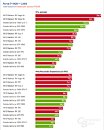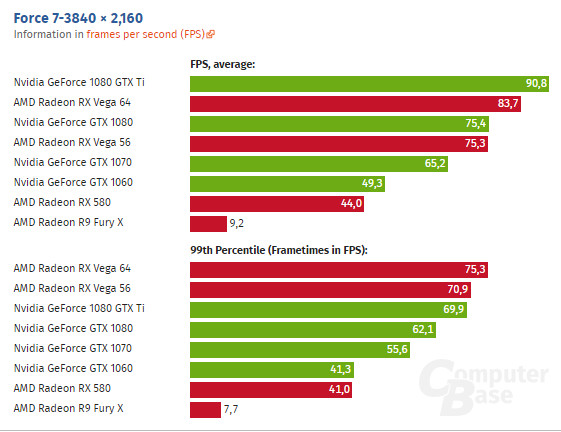Raevenlord
News Editor
- Joined
- Aug 12, 2016
- Messages
- 3,755 (1.21/day)
- Location
- Portugal
| System Name | The Ryzening |
|---|---|
| Processor | AMD Ryzen 9 5900X |
| Motherboard | MSI X570 MAG TOMAHAWK |
| Cooling | Lian Li Galahad 360mm AIO |
| Memory | 32 GB G.Skill Trident Z F4-3733 (4x 8 GB) |
| Video Card(s) | Gigabyte RTX 3070 Ti |
| Storage | Boot: Transcend MTE220S 2TB, Kintson A2000 1TB, Seagate Firewolf Pro 14 TB |
| Display(s) | Acer Nitro VG270UP (1440p 144 Hz IPS) |
| Case | Lian Li O11DX Dynamic White |
| Audio Device(s) | iFi Audio Zen DAC |
| Power Supply | Seasonic Focus+ 750 W |
| Mouse | Cooler Master Masterkeys Lite L |
| Keyboard | Cooler Master Masterkeys Lite L |
| Software | Windows 10 x64 |
In an interesting turn of events, AMD's latest flagship videocard, RX Vega 64, has seen a gaming performance analysis from fellow publication computerbase.de, which brought about some interesting - and somewhat inspiring findings. In their test system, which was comprised of a 4.3 GHz Intel Core i7-6850K (6 cores), paired with 16 GB of DDR4-3000 memory in quad-channel mode, and Crimson Relive 17.9.3 / GeForce 385.69 drivers, the publication found that the Vega 64 was outperforming the GTX 1080 Ti by upwards of 23%, and that percentage increases to 32% when compared to NVIDIA's GTX 1080. The test wasn't based on the in-game benchmark, so as to avoid specifically-optimized scenarios.



8x MSAA was used in all configurations, since "the game isn't all that demanding". Being it demanding or not, the fact is that AMD's solutions are one-upping their NVIDIA counterparts in almost every price-bracket in the 1920 x 1080 and 2560 x 1440 resultions, and not only by average framerates, but by minimum framerates as well. This really does seem to be a scenario where AMD's DX 12 dominance over NVIDIA comes to play - where in CPU-limited scenarios, AMD's implementation of DX 12 allows their graphics cards to improve substantially. So much so, in fact, that even AMD's RX 580 graphics card delivers higher minimum frame-rates than NVIDIA's almighty GTX 1080 Ti. AMD's lead over NVIDIA declines somewhat on 2560 x 1440, and even further at 4K (3840 x 2160). In 4K, however, we still see AMD's RX Vega 56 equaling NVIDIA's GTX 1080. Computerbase.de contacted NVIDIA, who told them they were seeing correct performance for the green team's graphics cards, so this doesn't seem to be just an unoptimized fluke. However, these results are tremendously different from typical gaming workloads on these graphics cards, as you can see from the below TPU graph, taken from our Vega 64 review.

View at TechPowerUp Main Site



8x MSAA was used in all configurations, since "the game isn't all that demanding". Being it demanding or not, the fact is that AMD's solutions are one-upping their NVIDIA counterparts in almost every price-bracket in the 1920 x 1080 and 2560 x 1440 resultions, and not only by average framerates, but by minimum framerates as well. This really does seem to be a scenario where AMD's DX 12 dominance over NVIDIA comes to play - where in CPU-limited scenarios, AMD's implementation of DX 12 allows their graphics cards to improve substantially. So much so, in fact, that even AMD's RX 580 graphics card delivers higher minimum frame-rates than NVIDIA's almighty GTX 1080 Ti. AMD's lead over NVIDIA declines somewhat on 2560 x 1440, and even further at 4K (3840 x 2160). In 4K, however, we still see AMD's RX Vega 56 equaling NVIDIA's GTX 1080. Computerbase.de contacted NVIDIA, who told them they were seeing correct performance for the green team's graphics cards, so this doesn't seem to be just an unoptimized fluke. However, these results are tremendously different from typical gaming workloads on these graphics cards, as you can see from the below TPU graph, taken from our Vega 64 review.

View at TechPowerUp Main Site







